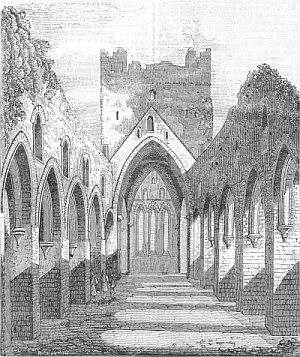Dunbrody Abbey, County Wexford
From The Illustrated Dublin Journal, Volume 1, Number 22, February 1, 1862
THIS ancient and venerable pile, anciently called Dunbrothy, situated
at Port St. Mary, once a small town near the confluence of the rivers
Barrow and Swire, (now Suir,) is a lasting monument of monastic
greatness; but the pealing anthem and the swelling choir have died away
in the distance, on the stream of time. Visiting this ancient pile, we
will never forget the awe which the grandeur of its stupendous arches
and gloomy cells imposed on us. The entrance is on the north side, and
a winding staircase brings the visiter to the top of the northern wing,
over whose broad wall he may walk in safety to the body of the
building, which is ascended by stairs of cut stone, till he arrives at
the turrets; some are bold enough to stand on their giddy heights, and
some years ago, a gentleman, in attempting the feat, fell to the
ground, and was killed on the spot.
Visiting this ancient pile, we
will never forget the awe which the grandeur of its stupendous arches
and gloomy cells imposed on us. The entrance is on the north side, and
a winding staircase brings the visiter to the top of the northern wing,
over whose broad wall he may walk in safety to the body of the
building, which is ascended by stairs of cut stone, till he arrives at
the turrets; some are bold enough to stand on their giddy heights, and
some years ago, a gentleman, in attempting the feat, fell to the
ground, and was killed on the spot.
Ware informs us that this Abbey was dependent on St. Mary's Abbey, at Dublin; Dugdale, on the other hand, calls it a cell to the Abbey of Bildewas, in England. These opinions, though apparently opposite, are not without some share of truth, for Jungelin says it had a dependence on St. Mary's, and it also paid a certain yearly acknowledgment to the Abbey of Bildewas, in token of its ancient dependence. Neither of these authors agree any better as to the time or circumstance of its foundation. It was founded, according to Ware's "Monastereologia," in the year 1182 A.D., by Hervaeus de Montemarisco. Du Chesne makes the founder, De Montmorency, marshal to Henry II., and seneschal of the Earl of Pembroke's lands; he further says, that this founder became a monk himself in the said Abbey, and was buried there.
The "Monasticon" acquaints us that Hervaeus de Montemarisco gave to the Abbey of Bildewas the lands of Ardfithein and Corsnorgop, with their dependencies, provided that they should build an Abbey at Dunbrothy, or St. Mary's Port, in Ireland, and for that purpose gave them the lands of Dunbrothy, on the further condition of their having a sanctuary in the Abbey for all malefactors that should fly thither, which Edward the Third confirmed. The charters in the "Monasticon" mention all these particulars; the Bishop of Ossory and a Bishop of Wexford signed the charter of foundation, whence, it may be concluded, that it passed in Ireland, and not in England; therefore Ware's opinion seems the more probable, did not those charters expressly make out, that the donation was made to the Abbey of Bildewas, in England and not to that of St Marys, Dublin; Jungelin agrees in this foundation, which he dates 1171, A.D., or 1175. Another difficulty occurs by Flatsburg asserting that the founder returning into England became a monk in the Abbey of the Holy Trinity, at Canterbury, which Mons. du Chesne denies in his genealogy of the house of Montmorency.
The principal benefactors to this Abbey are, first, Richard Strongbow, Earl of Pembroke, and Walter, his nephew, afterwards Earl of Pembroke, and after them, Harlemin, who, being a Bernardin monk, was made Bishop of Leaghlin, built some part of the church, and was buried in it, A.D. 1217.
The ruins of Dunbrody are great, and have a grandeur which at first sight inspires reverential awe, to which the solitude of the place and its wilderness not a little contribute The walls of the church are pretty entire as is the chancel. In the church are three chapels, vaulted and groined. The great aisle is divided into three parts by a double row of arches, supported by square piers; the inside of the arches have a moulding, which springs from beautiful consoles. The tower is rather low in proportion to the building and is supported by a grand arch. The foundation of the cloisters only remains; they were spacious. The western window is of uncommon form, and the western door under it was magnificent, with filligree work cut in the stone.
